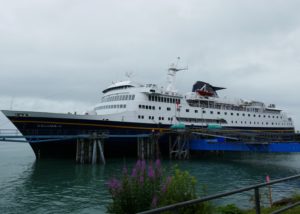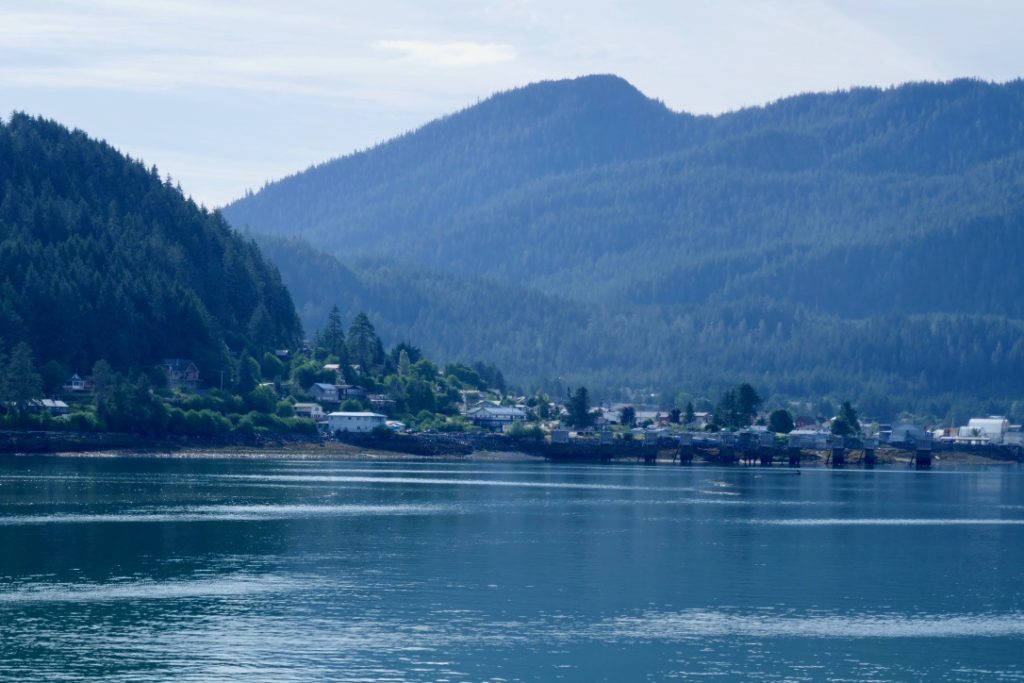 Wrangell is one of the oldest non-Native settlements in Alaska. Starting off with fur trading it became a bustling centre of commerce in the gold rushes. Good times continued with the growth of the fishing and fish canning industries, which provided much of the economic life for the town before the rise of logging in the 1950s.
Wrangell is one of the oldest non-Native settlements in Alaska. Starting off with fur trading it became a bustling centre of commerce in the gold rushes. Good times continued with the growth of the fishing and fish canning industries, which provided much of the economic life for the town before the rise of logging in the 1950s.
Changes in legislation led to the collapse of the timber industry in the early 90’s and the decline in fish numbers hit the fishing industry. Wrangell went from a bustling city to a sleepy town existing on some fishing and tourism with most of the young leaving to find work and houses for sale everywhere
In 2006 some enterprising businessmen decided to take advantage of Wrangell’s sheltered and ice free deep harbour and invested heavily in a full service boat yard and storage area. The yard now employs 120 people and has three lifts (300 ton, 150 ton and 40 ton trailer). It hauls out about 270 boats per year with the numbers rising as boats from all over Alaska take advantage of their service. 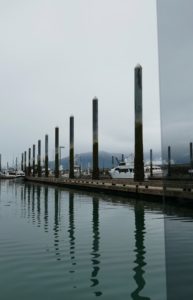
Our abode for the night was the Stikine Inn, Wrangell’s foremost hotel. We arrived early and had coffee and a bite to eat sitting out on the deck overlooking the harbour before being shown to our very comfortable room with the best deep bath I have ever come across. Ed went for a walk in town whilst I used the space to sort through the bags – and have a bath! Our stay was somewhat marred by the super thin walls and the guest next door who had his television blaring all night despite me thumping on the walls – a pity because otherwise it was a lovely place. 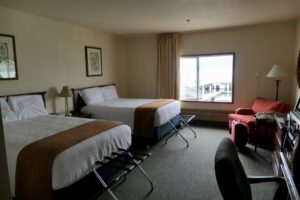
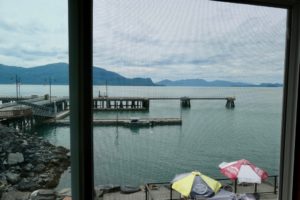
Anan Creek is an ancient Tlingit native fishing site at the south end of Wrangell Island and has the largest pink salmon run in Southeast Alaska. It attracts significant numbers of black and brown bears to feast on the bounty during the months of July and August. It is a unique spot because of the interaction between black and brown bears. Generally, brown bears run off the smaller black bears and the two species don’t share habitat. But at Anan Creek, most of the brown bears are adolescents, and the large, adult black bears don’t always back off, so you may spot brown and black bears fishing the same hole for pink salmon.
We had a great trip up the river to Anan Creek. It takes a little over an hour, the scenery is really beautiful and the going smooth. 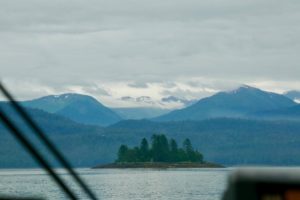
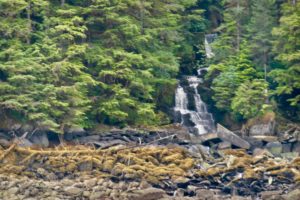
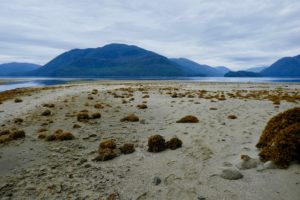 Our boat is purpose built and can be run up on the beach when the tide is out so you don’t get wet feet! James was our guide and Glen, having spent 10 years in the Navy, our expert helmsman (necessary because of the amount of logs, timber and crab pots in the water.
Our boat is purpose built and can be run up on the beach when the tide is out so you don’t get wet feet! James was our guide and Glen, having spent 10 years in the Navy, our expert helmsman (necessary because of the amount of logs, timber and crab pots in the water. 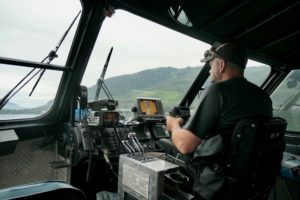 When we arrived at Anan Creek we were given a safety brief and warned again of the dangers of taking food ashore as this would attract the bears and lead to an interaction that you don’t want.
When we arrived at Anan Creek we were given a safety brief and warned again of the dangers of taking food ashore as this would attract the bears and lead to an interaction that you don’t want.
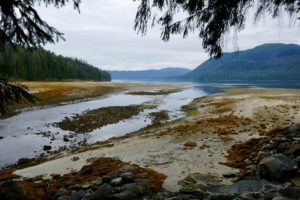 Anan Creek running into the sea at low tide
Anan Creek running into the sea at low tide
There is a half -mile trail leading to the observation deck and it is highly likely that you would see bears on the trail. The Forest Ranger at the trailhead again warned us about food (if you have anything other than water take it back to the boat immediately) and provided information on how to negotiate the path safely. If we met a bear coming the other way we were asked to keep our voices low and not to make any jerky movements that could upset the bear and whatever you do don’t run (emphasised and repeated several times) as bears will give chase.
James advice was to back off and leave him to deal with the bear. In his opinion the most dangerous part of the walk is falling off the walkway whilst looking around or photographing, the second most dangerous thing was slipping in the bear scat, which is everywhere. The bears see no reason to traverse the area through the wet forest when there is a perfectly good, dry walkway built for their convenience and they are very indiscriminate about where they poop. 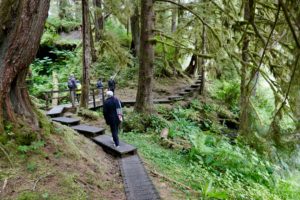
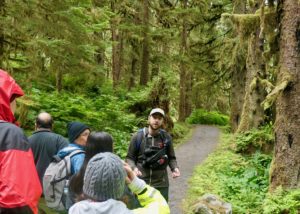
In the event we did not come face to face with a bear, brown or black just enjoyed the beautiful scenery  Though we were warned there was a brown bear ahead it had crossed the path before we got there and we spotted it ambling along the beach. This was the only brown bear we saw.
Though we were warned there was a brown bear ahead it had crossed the path before we got there and we spotted it ambling along the beach. This was the only brown bear we saw.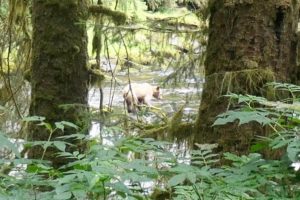
The facility consists of a covered viewing shelter, decks and a photo blind overlooking the cascading falls where the salmon jump up river and the bears catch their meal.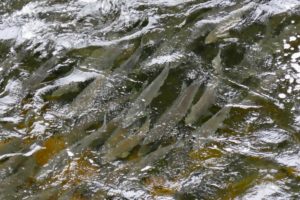
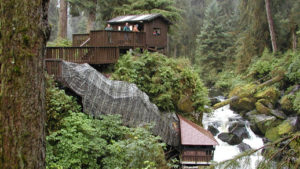
When we arrived there was a young black bear up a tree, calmly observing us, with two others in the creek fishing. 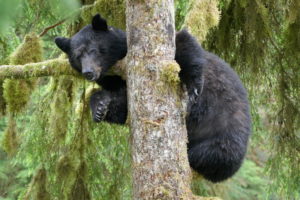 During the time we were there we met Arrow, the largest and oldest male bear,
During the time we were there we met Arrow, the largest and oldest male bear,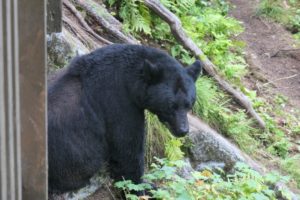 who hangs around the platform ambling down to catch a salmon every now and then and retreating to under the platform to eat his catch.
who hangs around the platform ambling down to catch a salmon every now and then and retreating to under the platform to eat his catch.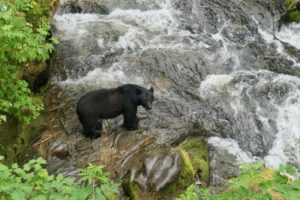
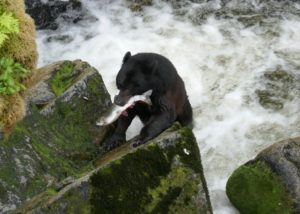 He passes so close you could pat him if you weren’t concerned about losing a hand.
He passes so close you could pat him if you weren’t concerned about losing a hand.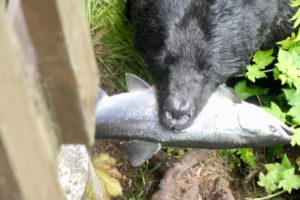 Due to his eating habits there was a definite fishy smell on the platform, which we were informed got worse as the summer progressed until in August it is almost unbearable. The eagles can’t get in under the platform to clean up and the rangers understandably won’t!
Due to his eating habits there was a definite fishy smell on the platform, which we were informed got worse as the summer progressed until in August it is almost unbearable. The eagles can’t get in under the platform to clean up and the rangers understandably won’t!
All in all we saw about 20 bears including Contessa, a mature female who was feeding her two cubs on a rock just across the stream. 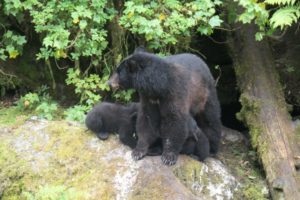 There is a system of caves on the other side where the bears live during the summer and they kept popping in and out of the caves to fish or just wander about.
There is a system of caves on the other side where the bears live during the summer and they kept popping in and out of the caves to fish or just wander about.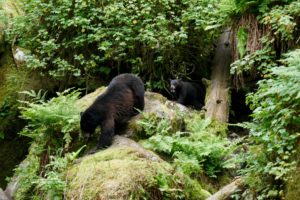
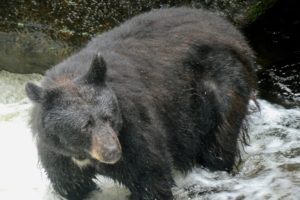
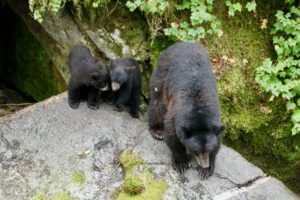
There are a large number of bald eagles, as well, who fish for the salmon a little further up. I watched as one hooked a salmon and settled down on a rock in the middle of the creek to eat his catch when a black bear came out of the forest and swiped it amongst a great flurry of wings.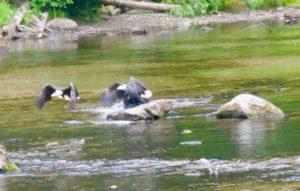
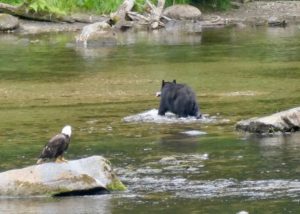
We spent a couple of hours at the Observatory and then traced our way back to the boat and headed home to a very late lunch/dinner before boarding the MV Columbia in the late afternoon. Our trip to the Observatory was such a unique and interesting experience and it is no wonder there were people from all over the world there and why it was one of the highlights of our trip to Alaska.